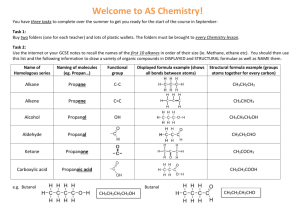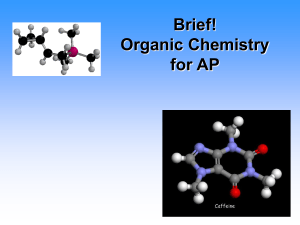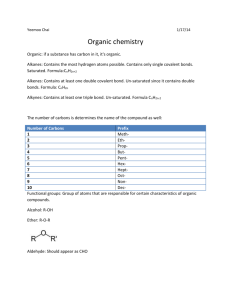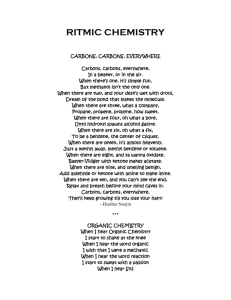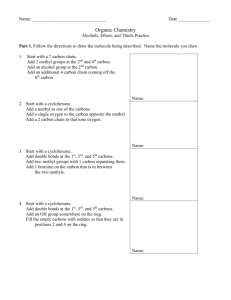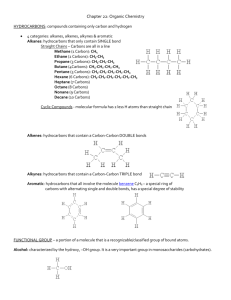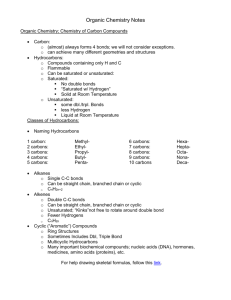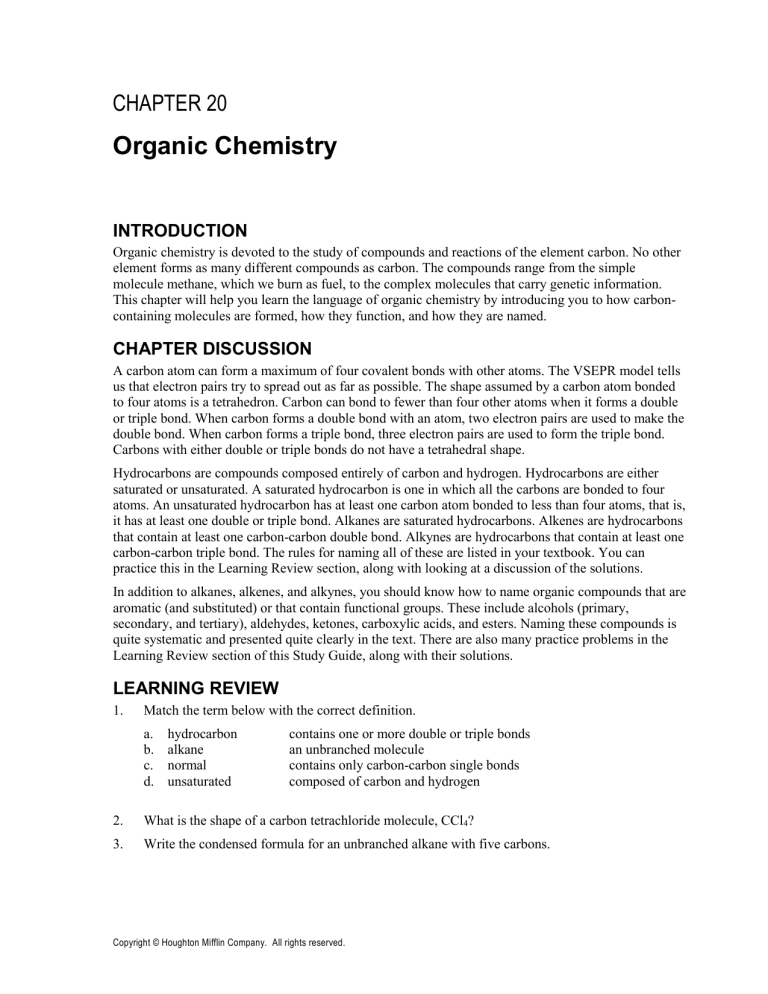
CHAPTER 20
Organic Chemistry
INTRODUCTION
Organic chemistry is devoted to the study of compounds and reactions of the element carbon. No other
element forms as many different compounds as carbon. The compounds range from the simple
molecule methane, which we burn as fuel, to the complex molecules that carry genetic information.
This chapter will help you learn the language of organic chemistry by introducing you to how carboncontaining molecules are formed, how they function, and how they are named.
CHAPTER DISCUSSION
A carbon atom can form a maximum of four covalent bonds with other atoms. The VSEPR model tells
us that electron pairs try to spread out as far as possible. The shape assumed by a carbon atom bonded
to four atoms is a tetrahedron. Carbon can bond to fewer than four other atoms when it forms a double
or triple bond. When carbon forms a double bond with an atom, two electron pairs are used to make the
double bond. When carbon forms a triple bond, three electron pairs are used to form the triple bond.
Carbons with either double or triple bonds do not have a tetrahedral shape.
Hydrocarbons are compounds composed entirely of carbon and hydrogen. Hydrocarbons are either
saturated or unsaturated. A saturated hydrocarbon is one in which all the carbons are bonded to four
atoms. An unsaturated hydrocarbon has at least one carbon atom bonded to less than four atoms, that is,
it has at least one double or triple bond. Alkanes are saturated hydrocarbons. Alkenes are hydrocarbons
that contain at least one carbon-carbon double bond. Alkynes are hydrocarbons that contain at least one
carbon-carbon triple bond. The rules for naming all of these are listed in your textbook. You can
practice this in the Learning Review section, along with looking at a discussion of the solutions.
In addition to alkanes, alkenes, and alkynes, you should know how to name organic compounds that are
aromatic (and substituted) or that contain functional groups. These include alcohols (primary,
secondary, and tertiary), aldehydes, ketones, carboxylic acids, and esters. Naming these compounds is
quite systematic and presented quite clearly in the text. There are also many practice problems in the
Learning Review section of this Study Guide, along with their solutions.
LEARNING REVIEW
1.
Match the term below with the correct definition.
a.
b.
c.
d.
hydrocarbon
alkane
normal
unsaturated
contains one or more double or triple bonds
an unbranched molecule
contains only carbon-carbon single bonds
composed of carbon and hydrogen
2.
What is the shape of a carbon tetrachloride molecule, CCl4?
3.
Write the condensed formula for an unbranched alkane with five carbons.
Copyright © Houghton Mifflin Company. All rights reserved.
184
Chapter 20: Organic Chemistry
4.
A branched alkane with the formula below has seven carbons. Can this alkane be represented by
the general formula CnH2n+2?
5.
What are structural isomers?
6.
Write all structural isomers of hexane, C6H14.
7.
Name the alkanes below.
a.
b.
c.
d.
e.
8.
Are the molecules a and b structural isomers of each other?
a.
b.
Copyright © Houghton Mifflin Company. All rights reserved.
Chapter 20: Organic Chemistry
9.
185
Write structural formulas for the molecules below.
a.
2-methyl-4-sec-butyloctane
b.
2-methylpropane
c.
3-ethylpentane
d.
2,2,4-trimethylhexane
10. Each of the alkane names below is incorrect. Write the structural formula for each molecule; then
name it correctly.
a.
2-ethylbutane
b.
1-methylpentane
c.
4,4-dimethylhexane
d.
2-ethyl-2-methylheptane
11. Petroleum itself is not very useful. It must be separated into fractions to be useful. How is
petroleum separated into the fractions that have useful properties?
12. When chlorine gas reacts with pentane, one of the hydrogens is substituted by a chlorine atom.
Several structural isomers are possible depending on which hydrogen atom is substituted. Show
all possible structural isomers that could be produced when chlorine reacts with pentane in the
presence of ultraviolet light.
13. Write the structures for the products of the reactions below.
a.
b.
c.
14. Name each of the molecules below.
a.
b.
c.
15. Write structural formulas for the products of the reactions below.
a.
b.
Copyright © Houghton Mifflin Company. All rights reserved.
186
Chapter 20: Organic Chemistry
c.
16. Name the aromatic hydrocarbons below.
a.
b.
c.
d.
17. Name the di-substituted aromatic hydrocarbons below.
a.
b.
c.
Copyright © Houghton Mifflin Company. All rights reserved.
Chapter 20: Organic Chemistry
d.
18. Name each of the alcohols below, and decide whether they are primary, secondary, or tertiary
alcohols.
a.
b.
c.
d.
e.
f.
19. Match the alcohols below with the appropriate description.
a.
b.
c.
d.
methanol
phenol
ethanol
ethylene glycol
used in antifreeze
found in alcoholic beverages
commonly known as wood alcohol
used in the production of plastics
Copyright © Houghton Mifflin Company. All rights reserved.
187
188
Chapter 20: Organic Chemistry
20. Show the structures of the aldehydes and ketones that would be produced from the oxidation of
the following alcohols.
a.
b.
c.
21. Name the aldehydes and ketones below.
a.
b.
c.
d.
e.
f.
Copyright © Houghton Mifflin Company. All rights reserved.
Chapter 20: Organic Chemistry
22. Match the structure with the functional group name.
a.
ketone
b.
ester
c.
aldehyde
d.
carboxylic acid
e.
alcohol
23. Show the structure of the carboxylic acid that is produced by oxidizing primary alcohols.
a.
b.
24.
a.
Show the structure of the ester formed when benzoic acid reacts with CH3OH.
b.
What is the name of the ester?
25. Name the carboxylic acids below.
a.
Copyright © Houghton Mifflin Company. All rights reserved.
189
190
Chapter 20: Organic Chemistry
b.
c.
26. Show the structure of the carboxylic acid and the alcohol that reacted to make the esters below.
a.
b.
27. Show the structure of the polymer that would be produced from the monomer below.
ANSWERS TO LEARNING REVIEW
1.
The correct matches are shown below.
a.
b.
c.
d.
hydrocarbon
alkane
normal
unsaturated
composed of carbon and hydrogen
contains only carbon-carbon single bonds
an unbranched molecule
contains one or more double or triple bonds
2.
In carbon tetrachloride, carbon is bonded to four other atoms. From the VSEPR model, four pairs
of bonding electrons spread out to form a tetrahedron.
3.
The condensed structure of an alkane with five carbons will have a CH3 on each end and three
CH2, or methylene, units. The structure is CH3(CH2)3CH3.
4.
This alkane has seven carbons and 16 hydrogens, so it can be represented by the general formula
CnH2n+2. Both straight-chain and normal alkanes are represented by the general formula CnH2n+2.
5.
Structural isomers are molecules that have the same numbers and kinds of atoms but a different
arrangement of bonds.
6.
One way to write all the structural isomers of a particular formula is to use the same system each
time. Hexane has six carbons in a chain, so first write the structure of hexane itself.
Copyright © Houghton Mifflin Company. All rights reserved.
Chapter 20: Organic Chemistry
191
Then remove a –CH3 from the end of hexane, which leaves five carbons in the chain. Remove an
–H from successive carbons on the chain, and replace it with the –CH3. If we remove an –H from
the end carbon and replace with the –CH3, we have not made a structural isomer because the new
molecule is just like hexane.
Put the –CH3 on carbon number two. The –CH3 is now located on the second carbon from the end.
This is a new structural isomer.
Now move the –CH3 to carbon number three.
The –CH3 is now located on the middle carbon, the third carbon from the end. We can move the
–CH3 to carbon number four, but this does not create a molecule with a different order. The
carbons have the same order as when the –CH3 is on the second carbon from the left. Both
structures have –CH3 on the second carbon from the end carbon.
same as
We have exhausted the structural isomers that can be made by moving one –CH3 from one
location to another. Let’s now remove another carbon from the chain and see what isomers can be
made from a chain with four carbons and two –CH3 groups.
Copyright © Houghton Mifflin Company. All rights reserved.
192
Chapter 20: Organic Chemistry
Substitute one –CH3 on the second carbon and one on the third carbon.
Now substitute both –CH3 groups on the second carbon.
If we put both –CH3 groups on the third carbon, we have not created a structure with a new order
of atoms. It is the same order as putting both –CH3 groups on carbon number two.
same as
We can make no more different structural isomers with a four-carbon chain and two –CH3 groups.
Take another carbon from the chain.
With a three-carbon chain and three –CH3 groups, there are no new structural isomers. All the
combinations we can make have the same order as ones we have already made. Thus there are
five structural isomers of C6H14.
Copyright © Houghton Mifflin Company. All rights reserved.
Chapter 20: Organic Chemistry
7.
193
You can name alkanes by applying the rules in Section 20.4 of your textbook.
a.
The longest continuous chain of carbon atoms has six carbons, so the parent alkane name is
hexane.
We need to number the parent chain, assigning number one to the end that is closest to the
first branch. In this case, the first branch, a –CH3 group, would be on carbon two regardless
of which end we begin numbering from. But beginning the numbering from the left would
locate the next branch, also a –CH3, on carbon three. If we began from the right, the second
substituent would be on carbon four.
We now need to name and number each group on the main chain. All three branches are
–CH3 groups. These are equivalent to methane molecules with a hydrogen removed and are
called methyl groups. There is a methyl group on carbons two, three, and five. When there is
more than one of a kind of substituent, use the prefix di, tri, and so on to indicate the number
of times the substituent appears. These substituents would be named 2,3,5-trimethyl.
Because there is only one kind of substituent, we do not have to list them in alphabetical
order. The entire name is 2,3,5-trimethylhexane.
b.
The longest continuous chain of carbon atoms has five carbons, so the parent alkane name is
pentane.
We can number this alkane from either end. There is only one substituent, and it is on the
middle carbon.
The group on carbon three is an isopropyl group, so this molecule is called 3isopropylpentane.
Copyright © Houghton Mifflin Company. All rights reserved.
194
Chapter 20: Organic Chemistry
c.
The longest continuous chain of carbon atoms has five carbon atoms, so the parent alkane
name is pentane. Remember that the longest chain will not always be drawn horizontally on
the page.
Number the chain beginning with the end on the right side in order to give the first
substituent the lowest possible number.
There are two substituents, both methyl groups, on carbons two and three. The substituents
are named 2,3-dimethyl. The whole name is 2,3-dimethylpentane.
d.
The longest continuous chain of carbon atoms has seven carbons, so the parent alkane name
is heptane.
You can also draw the box another way, which gives a chain of equal length.
Copyright © Houghton Mifflin Company. All rights reserved.
Chapter 20: Organic Chemistry
195
Number the chain from either end.
The substituents are a –CH3, or methyl group, on carbon four, and two CH3CH2–, or ethyl
groups, on carbons three and five. The two ethyl groups are named 3,5-diethyl. When
assembling the substituent names, list ethyl before methyl because the groups must be listed
alphabetically. The group names are 3,5-diethyl-4-methyl. The entire name is
3,5-diethyl-4-methylheptane.
e.
The longest continuous chain of carbons has three carbons, so the parent alkane name is
propane.
Number the chain from either end.
The substituents are two methyl groups on carbon number two. The substituents are named
2,2-dimethyl. The entire name is 2,2-dimethylpropane.
8.
One way to tell whether or not two molecules are structural isomers is to name them. If two
molecules have the same name, they are not structural isomers. They are the same molecule. If
two molecules have the same number of carbons and hydrogens, and they have different names,
they are structural isomers. Molecule a has five carbons in the longest chain, and molecule b also
has five carbons in the longest chain.
a
b
Number both molecules from the left. Each molecule has two substituents, two methyl groups.
The substituents on molecule a are 2,3-dimethyl, and on molecule b they are 2,4-dimethyl. The
entire name for molecule a is 2,3-dimethylpentane, and for molecule b it is 2,4-dimethylpentane.
The names are different. Each molecule has five carbons and twelve hydrogens, so they are
structural isomers.
Copyright © Houghton Mifflin Company. All rights reserved.
196
9.
Chapter 20: Organic Chemistry
Writing structural formulas from names is the reverse of writing names from formulas. First find
the parent alkane name, and write a carbon skeleton with the same number of carbons. Number
the chain from either direction. Determine how many substituents there are and where they are
attached; then put them on the chain. Fill in hydrogens so that each carbon is surrounded by four
other atoms.
a.
2-methyl-5-sec-butyloctane has the parent alkane name octane.
2-methyl indicates that there is a methyl group on carbon two.
4-sec-butyl indicates that there is a sec-butyl group on carbon four.
Now fill in the hydrogens so that each carbon is surrounded by four atoms.
b.
2-methylpropane has the parent alkane name propane.
2-methyl indicates a methyl group on carbon two.
Now fill in the hydrogens so that each carbon is surrounded by four atoms.
c.
3-ethylpentane has the parent alkane name pentane.
Copyright © Houghton Mifflin Company. All rights reserved.
Chapter 20: Organic Chemistry
3-ethyl indicates an ethyl group on carbon three.
Now fill in the hydrogens so that each carbon is surrounded by four atoms.
d.
2,2,4-trimethylhexane has the parent alkane name hexane.
2,2,4-trimethyl indicates there are three methyl groups, two on carbon two and one on
carbon four.
Now, fill in the hydrogen atoms so that each carbon is surrounded by four atoms.
10.
a.
2-ethylbutane has the structure
The longest carbon chain has not four, but five carbons, so the correct alkane name is
pentane. There is a methyl group on carbon three, so this is 3-methylpentane.
Copyright © Houghton Mifflin Company. All rights reserved.
197
198
Chapter 20: Organic Chemistry
b.
1-methylpentane has the structure
The longest chain has six carbons, not five, so the correct name is hexane.
c.
4,4-dimethylhexane has the structure
The longest chain has six carbons, so this is a hexane. The two methyl groups are on carbon
four. Numbering the chain from the other end would put the methyl groups on carbon three.
We want to number from the end that gives the substituents the lowest numbers, so 3,3dimethylhexane would be the correct name.
d.
2-ethyl-2-methylheptane has the structure
The longest chain has eight carbons, not seven, so the correct alkane name is octane. There
are two methyl groups on carbon three, so this is 3,3-dimethyloctane.
11. Petroleum is a mixture of hydrocarbons containing molecules with various numbers of carbons in
the chain. Usually, as the number of carbons in an alkane chain increases, the boiling point
increases. Petroleum can be separated into different fractions by boiling.
12. First draw the structure of pentane.
Then, begin at one end and remove a hydrogen atom and replace it with a chlorine atom.
Copyright © Houghton Mifflin Company. All rights reserved.
Chapter 20: Organic Chemistry
199
There is only one structural isomer that can be produced from pentane by removing a hydrogen
from carbon one. The order of bonding does not change by replacing either of the other two
hydrogen atoms on carbon number one.
same as
same as
Now, remove a hydrogen atom from carbon two and replace it with a chlorine atom. There is one
structural isomer with a chlorine atom on carbon two.
Remove a hydrogen atom from carbon three, and replace it with a chlorine atom. There is one
structural isomer with a chlorine atom on carbon three.
Substituting a chlorine atom on carbon atoms four or five does not produce a new structural
isomer, so there are three structural isomers.
13.
a.
In this reaction, a chlorine atom substitutes for a hydrogen atom.
b.
This is an example of a combustion reaction.
c.
This is an example of a dehydrogenation reaction.
14. The rules for naming alkenes and alkynes are given in Section 20.7 of your textbook.
a.
The longest chain that contains the double bond has five carbons.
Copyright © Houghton Mifflin Company. All rights reserved.
200
Chapter 20: Organic Chemistry
Replace the -ane ending of pentane with -ene to produce pentene. Number the carbon chain
from the end closest to the double bond.
Give the location of the double bond by putting a number in front of the alkene name. This
molecule is 1-pentene. There is an ethyl group on carbon two, so this molecule would be
named 2-ethyl-1-pentene.
b.
The longest chain that contains the triple bond has seven carbons.
Replace the -ane ending of heptane with -yne to produce heptyne. Number the carbon chain
from the end closest to the triple bond.
Give the location of the triple bond by putting a three in front of heptyne. There are two
methyl groups attached to the chain on carbons two and six. This molecule would be named
2,6-dimethyl-3-heptyne.
c.
The longest chain that contains the double bond has four carbons.
Replace the -ane ending of butane with -ene to produce butene. Number the carbon chain
from either end to give the location of the double bond the smallest number.
Give the location of the double bond by putting a number in front of the alkene name. This
molecule is 2-butene. There are two methyl groups attached to the main chain on carbons
two and three. This molecule would be named 2,3-dimethyl-2-butene.
15.
a.
b.
Copyright © Houghton Mifflin Company. All rights reserved.
Chapter 20: Organic Chemistry
c.
16.
a.
This molecule is usually called toluene.
b.
This molecule is named as a pentane with two substituents. There is a chlorine atom on
carbon three and a phenyl group on carbon two. The name of this molecule is 3-chloro-2phenylpentane.
c.
This molecule is chlorobenzene.
d.
This molecule is nitrobenzene.
17.
a.
b.
c.
is 1,2-dinitrobenzene or o-dinitrobenzene
is 4-chlorophenol or p-chlorophenol
is 4-ethyltoluene or p-ethyltoluene
Copyright © Houghton Mifflin Company. All rights reserved.
201
202
Chapter 20: Organic Chemistry
d.
is 3-bromotoluene or m-bromotoluene
18.
a.
The longest chain that contains the –OH has five carbons.
Number the chain from the left side so that the –OH group and the substituents have the
lowest possible numbers. Drop the -e ending from pentane, and replace with -ol to produce
pentanol. Locate the –OH group with a number. This molecule would be 3-pentanol. There
are two methyl groups on carbon two, so the entire name would be 2,2-dimethyl-3-pentanol.
The carbon to which the –OH is attached is bonded to two hydrocarbon fragments, so this is
a secondary alcohol.
b.
The longest chain that contains the –OH has four carbons.
Number the chain from the top so that the –OH group has the lowest possible number. Drop
the -e ending from butane, and add -ol to produce butanol. Locate the –OH group with a
number. This molecule would be 2-butanol. There is a methyl group on carbon two, so the
entire name is 2-methyl-2-butanol. The carbon to which the –OH is attached is bonded to
three hydrocarbon fragments, so this is a tertiary alcohol.
c.
The longest chain that contains the –OH group has six carbons.
Begin numbering from the right to give the –OH the lowest possible number. Drop the -e
ending of hexane and add -ol to produce hexanol. Locate the –OH group with a number.
This molecule would be 1-hexanol. There are two methyl groups on carbons three and four,
and a bromo group on carbon four. The entire name would be
4-bromo-3,4-dimethyl-l-hexanol. The carbon to which the –OH is attached is bonded to one
hydrocarbon fragment, so this is a primary alcohol.
Copyright © Houghton Mifflin Company. All rights reserved.
Chapter 20: Organic Chemistry
d.
203
The longest chain that contains the –OH has eight carbons.
Begin numbering from the carbon that has the –OH. Drop the -e ending of octane, and add ol to produce octanol. Locate the –OH group with a number. This molecule would be
1-octanol. There is a methyl group on carbon two and an isopropyl group on carbon four.
The entire name would be 2-methyl-4-isopropyl-l-octanol. The carbon to which the –OH is
attached is bonded to one hydrocarbon fragment, so this is a primary alcohol.
e.
The longest chain has one carbon. Assign this carbon number one.
CH3OH
Drop the -e ending of methane and add -ol to produce methanol. Because there is only one
carbon, we do not need a number to locate the –OH group. It can be found only on carbon
one. There are no substituents, so methanol is the entire name. This molecule is also known
by the common names methyl alcohol and wood alcohol. The carbon to which the –OH is
attached is bonded to one hydrocarbon fragment, so this is a primary alcohol.
f.
The longest chain that contains the –OH has nine carbons.
Begin numbering from the right to give the –OH the lowest possible number. Drop the -e
ending of nonane, and add -ol to produce nonanol. Locate the –OH with a number. This
molecule would be 2-nonanol. There are two ethyl groups on carbons four and seven. This
molecule would be named 4,7-diethyl-2-nonanol. The carbon to which the –OH is attached
is bonded to two hydrocarbon fragments, so this is a secondary alcohol.
19. Match the alcohols below with the appropriate description.
a.
b.
c.
d.
methanol
phenol
ethanol
ethylene glycol
commonly known as wood alcohol
used in the production of plastics
found in alcoholic beverages
used in antifreeze
20.
a.
Copyright © Houghton Mifflin Company. All rights reserved.
204
Chapter 20: Organic Chemistry
b.
c.
21.
a.
The longest chain that contains the carbonyl has four carbons. Begin numbering from the
end that has the aldehyde group.
Drop the -e ending of butane, and add -al to produce butanal. Since the carbonyl in
aldehydes is always found on an end, do not use a number to locate the carbonyl. There are
three methyl groups, two on carbon three and one on carbon two. This molecule would be
named 2,3,3-trimethylbutanal.
b.
The longest chain that contains the carbonyl has six carbons. Begin numbering from the end
that is closest to the ketone group.
Drop the -e of hexane, and add -one to produce hexanone. Locate the ketone carbonyl with a
number, 2-hexanone. There is an ethyl group on carbon four, so the entire name would be
4-ethyl-2-hexanone.
c.
The longest chain that contains the carbonyl has seven carbons. Begin numbering from the
end that has the aldehyde group.
Drop the -e ending of heptane, and add -al to produce heptanal. There is a bromo group on
carbon two, so the entire name is 2-bromoheptanal.
Copyright © Houghton Mifflin Company. All rights reserved.
Chapter 20: Organic Chemistry
d.
205
The longest chain that contains the carbonyl has six carbons. Begin numbering from the
right to give the ketone the lowest number.
Drop the -e ending of hexane, and add -one to produce hexanone. Locate the ketone with a
number. This molecule would be 2-hexanone. There is an ethyl group on carbon three and a
methyl group on carbon four. The entire name would be 3-ethyl-4-methyl-2-hexanone.
e.
The longest chain that contains the carbonyl has four carbons. Begin numbering from the
right to give the ketone carbonyl the lowest number.
Drop the -e of butane, and add -one to produce butanone. Locate the ketone with a number.
This molecule would be 2-butanone. There is a methyl group on carbon three and a phenyl
group on carbon four. The name would be 3-methyl-4-phenyl-2-butanone.
f.
The longest chain that contains the carbonyl has five carbons. Begin numbering from the end
with the aldehyde group.
Drop the -e of pentane and add -al to produce pentanal. The aldehyde group does not need a
number because it is always on the end. There are two methyl groups on carbon two and two
chloro groups on carbon three. The name would be 3,3-dichloro-2,2-dimethylpentanal.
22.
a.
aldehyde
b.
carboxylic acid
c.
alcohol
Copyright © Houghton Mifflin Company. All rights reserved.
206
Chapter 20: Organic Chemistry
d.
ketone
e.
ester
23.
a.
b.
24.
a.
b.
The part of the ester that came from the alcohol is called methyl. The part of the ester that
came from the carboxylic acid is called benzoate. The name is methylbenzoate.
a.
The longest carbon chain that contains the carboxylic acid functional group has seven
carbons. Number the chain from the end that has the carboxylic acid group.
25.
Drop the -e of heptane, and add -oic acid to give heptanoic acid. There is a methyl group on
carbon three and an ethyl group on carbon five. The name is 5-ethyl-3-methylheptanoic acid.
b.
The longest chain of carbons that contains the carboxylic acid functional group has four
carbons. Begin numbering from the right to give the carboxylic acid functional group the
lowest number.
Copyright © Houghton Mifflin Company. All rights reserved.
Chapter 20: Organic Chemistry
207
Drop the -e ending and add -oic acid to give butanoic acid. There is a bromo group on
carbon four, so the name would be 4-bromobutanoic acid.
c.
The longest chain of carbons that contains the carboxylic acid functional group has four
carbons. Begin numbering from the right to give the carboxylic acid functional group the
lowest number.
Drop the -e ending, and add -oic acid to give butanoic acid. There is a methyl group and an
ethyl group on carbon two. The entire name would be 2-ethyl-2-methylbutanoic acid.
26.
a.
b.
is made from
is made from
27. The polymer would have the structure below.
Copyright © Houghton Mifflin Company. All rights reserved.
plus
plus

